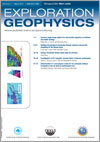
Exploration Geophysics
Volume 43 Number 1 2012
EG11038 Common-angle image gathers for shot-profile migration: an efficient and stable strategy
In this paper, we first revisit the popular schemes of generating ADCIGs by wavefield continuation migration. Then we present an alternative approach to produce common-angle image gathers after shot-profile migration based on a one-way wave equation. The angle information is obtained from a division of two images: the conventional image and the angle-weighted image. The effects of sparse shot sampling on extracting ADCIGs have also been investigated.
EG11028 Building 3D geological knowledge through regional scale gravity modelling for the Bowen Basin
Regional scale gravity modelling improves the geological understanding of large scale structures like the Bowen Basin. With gravity modelling, calibrated by boreholes and seismic reflection profiles, we produce geologically reasonable 3D surfaces and structures that provide an important framework for thermal models and a platform for expansion with new information.
This work presents a 3D geological model of the Sydney–Gunnedah–Bowen Basin, developed for application in high resolution large scale thermal models using integrated regional scale gravity modelling combined with borehole and seismic data constraints, to provide a better understanding of the 3D upper crustal structure of the basin system.
EG10021 Investigation of ULF magnetic anomaly before moderate earthquakes
ULF emissions can provide information regarding earthquake precursors. Spectral density and polarization ratio methods are used to extract earthquake precursory signatures. For moderate earthquakes (magnitudes Mb = 3.7–4.8), we have found enhancement (±3 h around the main shock time) in magnetic field intensity 3 to 5 days before the main shock.
EG11006 Determination of a rock physics model for the carbonate Fahliyan Formation in two oil wells in southwestern Iran
Investigation of rock physics is a way to predict reservoir geomechanical parameters. In this paper, we review rock physics models, and compare them with real data trends for a carbonate reservoir in southwestern Iran (the Fahliyan Formation). The best model for clean carbonate of the Fahliyan Formation was developed in two oil wells.

